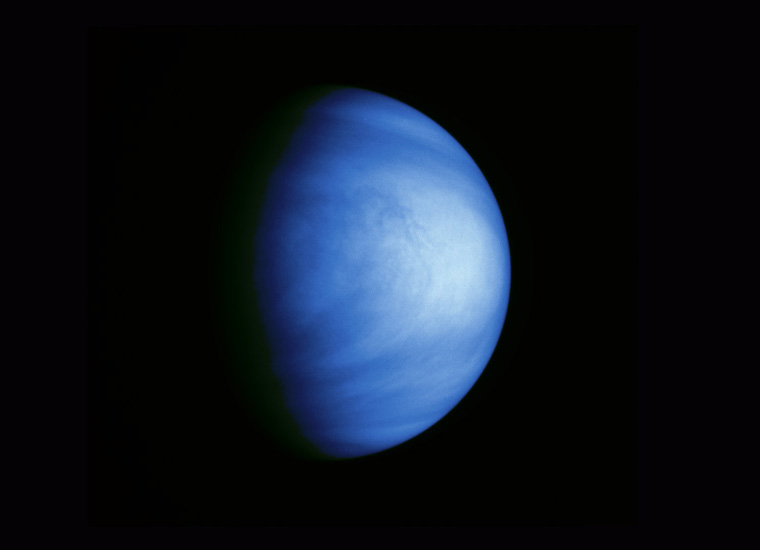If the earth had a twin planet, it would be Venus. The two planets are approximately equal in size, weight, composition and their distance from the sun. One big difference is that there are no oceans on Venus. Venus is surrounded by a thick, rapidly swirling cloud layer that retains the heat at the surface. This causes an extreme greenhouse effect, similar to that on Earth. The temperatures are hot enough to melt lead and the intense pressure is comparable to the pressure in the ocean at a depth of 900 m. The Venus reflects so much sunlight that it is usually the brightest planet in the sky.

The atmosphere mainly consists of carbon dioxide, droplets of acid rain but no water vapor – so not an ideal place for people and plants. Although the thick atmosphere allows the heat of the sun shining through, it also prevents the heat from escaping back into space. So there is a temperature of about 450° C on the surface of Venus, which is hotter Mercury´s surface, although it is the closest planet to the sun. Due to the density of the atmosphere (90 times greater than the pressure on the earth) each probe ever landed on the Venus survived only a few hours until it was crushed. The clouds of the uppermost layer move faster than hurricanes on Earth.
Venus rotates once on its axis in 243 Earth days and once around the sun in 225 Earth days. So a day on Venus lasts longer than a Venus year. The Venus rotates retrograde or backward – in the opposite direction to its orbit around the sun. Seen from the surface of Venus the sun would rise in the west and set in the east.
Earth and Venus are very similar in their density and chemical composition. Both have a relatively young surface, the Venus has confirmed only 300 to 500 million ago years.
The surface of Venus is composed of about 20% levels, about 70% of hills and about 10% from highlands. The surface was formed by volcanism, impacts and dislocations of the crust. There were no active volcanoes found, but the high concentration of sulfur dioxides in the atmosphere indicates that there might be some active volcanoes.
There are no rainfalls, oceans or storms that erode the surface, but there are still weathering and erosion processes. On the surface blows a slight wind with not more than a few km/h which is sufficient to characterize the surface with sand drifts and dunes. In addition the corrosive atmosphere decomposes the rock. The size of the impact crater is determined by the dense atmosphere: Small buildings burn upon entering the atmosphere, only the bigger ones hit on the surface and leave a crater.
Over 1000 volcanoes with a diameter of more than 20 km draw the surface of Venus. There are probably 1 million volcanoes with a diameter more than 1 km. Most of the surface is covered by vast lava flows. In the north there exists a region named Ishtar Terra which lava filled valley that is larger than the United States. Near the equator extends the Aphrodite Terra Mountain over an area of about 10 000 km, which has about half the size of Africa. The lava flows have also caused some 100 km long channels in the surface.
With few exceptions, the structures of Venus are named after women of our cultural history.
The interior of Venus is probably similar to the Earth. It has an iron core with a radius of about 3000 kilometers and a molten rocky mantle covering most of the Venus. Current results of the Magellan probe indicate that the crust is stronger and thicker than originally anticipated. The Venus has neither moon nor a magnetic field, but the solar winds generate an apparent field around Venus.
| Discovery date | unknown |
| Semi-major axis | 108 159 260 km = 1.081 x 108 km (0.723 AU) Comparison: 0.723 x Earth |
| Perihelion | 107 411 270 km = 1.074 x 108 km (0.718 AU) Comparison: 0.718 x Earth |
| Aphelion | 108 907 249 km = 1.089 x 108 km (0.728 AU) Comparison: 0.728 x Earth |
| Diameter | 12 103.6 km = 1.21036 x 104 km Comparison: 0.9488 x Earth |
| Circumference | 38 025 km = 3.8025 x 104 km |
| Volume | 928 400 000 000 km3 = 9.284 x 1011 km3 Comparison: 0.88 x Earth |
| Mass | 4 868 500 000 000 000 000 000 000 kg = 4.8685 x 1024 kg Comparison: 0.815 x Earth |
| Density | 5.24 g/cm3 Comparison: 1.0525 x Earth |
| Surface area | 460 200 000 km2 = 4.602 x 108 km2 Comparison: 0.902 x Earth |
| Surface gravity | 8.87 m/s2 Comparison: Someone with 100 kg on Earth, would weigh 91 kg on Venus. |
| Escape velocity | 37 300 km/h = 1.036 x 104 m/s Comparison: 0.927 x Earth |
| Sidereal rotation period | 243 Earth days 5832 hours |
| Orbital period (Length of a year) |
0.615 Earth years 224.7 Earth days |
| Average orbital speed | 126 077 km/h = 35 021.4 m/s Comparison: 1.176 x Earth |
| Eccentricity | 0.068 Comparison: 0.405 x Earth |
| Inclination | 3.39° |
| Axial tilt | 177.3° Comparison: 7.56 x Earth |
| Peripheral orbit | 675 300 000 km = 6.753 x 108 km Comparison: 0.731 x Earth |
| Minimum/Maximum surface temperature |
462 °C = 735 K Comparison: The temperature of the Earth is ~ 185/331 K |
| Composition of the atmosphere |
Carbon dioxide (CO2), Nitrogen (N2) Comparison: The atmosphere of the Earth is mainly composed of N2 and O2. |
Moons:
Venus has no moon.